In episode 2 of Quite By Accident, Steve Hess recounts some of the lines he wrote for President Eisenhower’s speeches, including a word he made up that the president used. Host Katie Dunn Tenpas also asks about Eisenhower’s most famous line: the military-industrial complex.
- Listen to Quite By Accident on Apple, Spotify, or wherever you like to get podcasts.
- Watch on YouTube.
- Learn about other Brookings podcasts from the Brookings Podcast Network.
- Sign up for the podcasts newsletter for occasional updates on featured episodes and new shows.
- Send feedback email to [email protected].
- Thanks to: Kuwilileni Hauwanga, supervising producer; Fred Dews, senior producer; Gastón Reboredo, audio engineer; Daniel Morales, video editor; Colin Cruickshank, videographer; Katie Merris, art designer; Tracy Viselli and Adelle Patten, Governance Studies communications.
Transcript
HESS: If there are no changes, tomorrow will be the first time the president speaks any of my words.
TENPAS: Steve Hess, reading his diary entry from September 25th, 1958.
HESS: The event is the restoration of Fort Ligonier in western Pennsylvania, a frontier post during the French and Indian War. George Washington fought there in 1758. Now, my assignment was to thread a connection between Washington and Eisenhower, the two war hero presidents.
[military music]
But what I learned is that Colonel Washington’s troops had circled the fort clockwise in heavy fog, while another young officer from Virginia circled his troops counterclockwise. They met, mistook each other for the enemy, and two officers and 38 enlisted men killed or wounded.
Recounting George Washington’s friendly fire is not the best way for me to start my career as a White House speechwriter.
All that survived of my first draft was one sentence: “Thanks to the public interest of many citizens, a large part of this historic site has been restored so that today we see it much as it must have appeared to young Colonel Washington 200 years ago.”
[music]
TENPAS: This is episode two of Quite By Accident, a podcast about Steve Hess and his life at the center of American politics. I’m Katie Dunn Tenpas, a visiting fellow and director of the Katzmann Initiative at the Brookings Institution, and a practitioner senior fellow at the University of Virginia’s Miller Center. I’ve known Steve for decades myself, but as you’ll learn in this podcast, his experience in and around politics and powerful people goes back … way back.
In episode one, Steve talked about how he as a young man of 25 landed a job as a speechwriter in the Eisenhower White House, and then his first impressions of working there. People were nice to him in unexpected ways, even though most of the staffers had been there for seven years.
On this episode, Steve talks about the job he was hired for—speechwriting—how they did it back then, some of the speeches he worked on, and, at the end he’ll tell you who actually wrote Eisenhower’s famous military-industrial complex speech.
You just heard him talking about the 1958 speech President Eisenhower delivered at Fort Ligonier in Western Pennsylvania, a place where two hundred years prior Colonel George Washington led troops during the French and Indian War. In 1959, Steve worked on a speech he calls the “Tin Lizzie” speech, which had a connection to his father, who, as Steve recounted in episode one, owned an automobile agency during Steve’s childhood.
HESS: But let me tell you one about which was an important speech, called “Security in the Free World,” which was on March 16th, 1959. Big radio, TV speech. And the line that I’m proud of is “the first model of any new piece of equipment is always relatively primitive. The first sewing machine, the first typewriter, the first automobile all left much to be desired. And even the rockets that dazzle us today will soon become Model Ts, the Tin Lizzie’s of the Missile Age.”
TENPAS: So, how did you know what a Tin Lizzie was?
HESS: Ahh, I knew what a Tin Lizzie was because my father happened to be [in the] automobile business. But the Washington Daily News took note of this, and they wrote, “President Eisenhower tossed in a nostalgic term during his grim talk to the nation on Monday night. To most people under 40 years of age, the Model T is a well enough known name, but the Tin Lizzie is something else, for it has not been in popular use since 1925.”
Okay, that’s not bad for somebody who’s 25, I thought at the time. And what happened of course, I was so delighted with this that I immediately sent the clipping to my mother, who saved everything. And so, that’s why I have it today, to be able to read it to you.
TENPAS: “Security in the Free World” was indeed a very important speech by President Eisenhower, but Steve told me that perhaps the speech he was the proudest of was one where he made up a word that made it into the president’s remarks.
…
TENPAS: You made up a word?
HESS: Well I made up a word for the president.
TENPAS: For the president of the United States?
HESS: That’s right.
TENPAS: Okay, and you’re 25 years old?
HESS: That’s right, all of the above. This this was all in the midterm election of 1958. And it was going to be a disaster for the Republican Party.
[music]
And I was told, instructed, that in every one of my speeches I was supposed to attack the Democrats as “the party of gloom and doom.” I got so tired of that by the last speech the president was to give in Baltimore, and we all gathered to go over the draft I had done for that. Instead of writing that it was a party of gloom and doom, I invented the word “gloomdoggler.”
TENPAS: Gloomdoggler?
HESS: Gloomdoggler. And this was based on a word “boondoggler” that was used in the Depression by the Republicans to attack Democrats. Boondoggler for making unnecessary work. So, I wrote “gloomdoggler” meaning making unnecessary gloom.
Well, my colleagues in that room hated this. And they let me keep it in the speech I think on the theory that when it got to President Eisenhower, he would throw it out anyway. But he loved it!
So, we all went over to Baltimore to hear the speech. And as we came out of the speech, there they’re selling the Baltimore Sun, the bulldog edition. And there it is across eight columns on the first page, type that could’ve announced the beginning of a war, and it says, “Ike calls Democrats ‘gloomdogglers’ in speech here closing the campaign.”
TENPAS: Wow. So, it was the headline of the speech, that new word.
HESS: And that headline. Of course… it’s there, it’s still in my office. There it is right behind you, Katie.
TENPAS: Wow.
[music]
HESS: That is the only piece of sort of political memorabilia that I’ve kept all these years. I made up that word. I was proud of the word. There was only one thing wrong. Only two people ever use the word again: Dwight Eisenhower and me.
TENPAS: Let’s back up a minute. You’ve heard how 25-year-old Steve Hess rather unexpectedly found his way to the White House staff, and you’ve just heard him recalling some of the speeches he worked on. But what was the speechwriting process like? Who else was on the team?
In today’s White House, there is a director of speechwriting and a team larger than three people dedicated to shaping the president’s message. This function was formalized in 1964, in Lyndon Johnson’s administration. But Steve was there at a time when it was all more informal.
HESS: There were really three of us, or two and a half of us. Because when Mac got to the East Wing—
TENPAS: —“Mac” Moos, Steve’s mentor from Baltimore. We met him in episode one—
HESS: —where the military aides were there. The assistant military aide, whose name was Ralph Williams, stopped by and knocked on the door and said, Can I help you? He apparently didn’t have much to do. And it turned out that he had won the contest for the best military essay, naval essay. And Mac, of course, was thrilled, that he wanted to help because Mac had had no military experience.
So, the three of us were Mac Moos, myself, and Ralph Williams.
TENPAS: For all the president’s speeches, there were three people?
HESS: Three people. And the way we would do it, the president liked to have a full text. So, we would start off, the three of us, talking about what we thought was in it. And each one of us that would write what we thought the speech should be. And Mac would then take it and put it together as the final speech that he would take in to the president.
So, all of these things were numbered “MM,” for Malcolm Moos. Really you look in the files and you really don’t see anything there for myself or Ralph Williams.
Well, it was sort of interesting, because he didn’t have a signature the way Kennedy or Nixon had a signature. They were sort of a non-signature speech that he wanted them to be simple and plain. We rarely had a joke, I think in the two plus years that was there, we only wrote one joke for the president.
TENPAS: Wow.
HESS: I won’t tell you, it was such a bad joke.
TENPAS: Steve did not share the joke, but he did say that Eisenhower was, quote, “a tremendous editor.”
HESS: People didn’t realize he had been the speechwriter for Douglas MacArthur. And he was very good.
And I used to keep one little what we call a Rose Garden rubbish speech, an introduction to some group, in my desk to show people when they said, Oh, the president is so inarticulate. And I would show them the changes that he made. It was full of these soft lead pencil changes.
[music]
And actually his changes were better than the things I had written for him. So, he was a very good editor.
TENPAS: So, the White House speechwriting team in the last years of the Eisenhower administration was just three men: Mac Moos, Ralph Williams—whose official job was assistant to the president’s naval aide—and Steve. But also, there were typewriters … and secretaries.
But also at this time, you’re on a typewriter and you’re having to use white out?
HESS: No, I had a secretary in this glorious office. I also had a secretary because not only did everything have to be typed, but it had to be typed perfectly. There couldn’t be a mistake if it went to the president. You made a mistake, retype it.
TENPAS: So, they were the ones retyping and retyping and retyping?
HESS: They were the ones retyping and retyping. Exactly.
TENPAS: You were on Easy Street then.
HESS: Oh, was I on Easy Street.
TENPAS: What were your hours like? Did you think you worked maybe 40 or 50 or 60 hours a week?
HESS: Well I worked … put it this way.
TENPAS: Because nowadays it’s like 60 to 80.
HESS1: I can tell you, it was loose enough that Mac Moos and I actually wrote a book as well.
TENPAS: While you were working in the White House?
HESS: That’s right. It was called, Moos and Hess, Hats in the Ring.
TENPAS: Hats in the Ring, published in 1960, was about the presidential nominating system and would be the very first of nearly twenty books that Steve has authored or coauthored.
[music]
An important fact about the White House in the 1950s, and for decades later, was that its staff was much smaller than it is today—maybe 50 people at a given time—and they were very much white and male.
HESS: This as you think back, is is heart rendering. There were 80 people who had had White House privileges in his eight years. Fifty when I was there, but 80 all over. Putting aside the military aides, of those 80 people, there were only three women.
TENPAS: Three?
HESS: Three women. And one African American.
TENPAS: One?
HESS2: Yeah, the three women: one was the president’s secretary; the other one was the first lady’s social secretary; and the third was an assistant press secretary. Those were the three women.
The man, Fred Morrow, only one. And yet it was publicized and in the paper that he was the first African American to have a professional role in the White House. They were proud of the fact, but he was only one.
TENPAS: What was his role?
HESS: His role was as an administrative officer. That didn’t sound very important by title, but was very important to people like us, had to do with offices and arrangements of the White House itself.
[music]
I guess he had supposedly, supposed to have some role in terms of reaching out to African Americans, but it was later where there was an aide for that and an aide for Jews and an aide for Hispanics and so forth.
I liked him a lot and we talked, but I did not realize how hard it had been on him.
TENPAS: It must have been difficult.
HESS: Yeah.
TENPAS: I’ll have more to share with you from Steve about the White House staff in the next episode. But now, back to speeches. Considering the fact that he and Mac Moos had time to write a book together, did he actually have enough work to do? Well, I learned that the job wasn’t all about writing speeches after all.
HESS: Well, let’s put it this way. When I say we weren’t very busy we would do maybe the equivalent of one major speech a week or two weeks. But we would do lots of things that were greetings to groups, groups that came to the White House, were on the lawn, and so forth. So, we were modestly busy, but maybe not on the major speeches.
I mean, there were major speeches. For example, if I had a major speech like the one I mentioned about the military, I might have a meeting with some military people. Remember, my office was so big that I had room for a table that ten people could sit at.
So, I would call in people. We would have a meeting. I would make sure to put a pad of White House paper on each plate.
TENPAS: For a souvenir?
HESS: Yeah. Knowing that when they left, they would take their pad of paper with them.
TENPAS: No M&M’s back then?
HESS: No, no, no, no, no. Again, and excuse me, as a researcher, as we have been for all these years at Brookings, it’s totally different when you’re a researcher from the White House and you call the Pentagon and you say, Hey, what’s the number that I need on such and such?
TENPAS: In January 1961, in the final weeks of the administration, President Eisenhower delivered his final State of the Union message to Congress. Like the nineteenth-century presidents, it wasn’t in person—though Ike had delivered seven of them to Congress in person.
Steve worked on that speech, and told me one passage in particular that he was, deservedly, very proud of.
[music]
HESS: That final farewell speech—what they gave me to work on was something called the annual State of the Union speech, which is delivered to Congress. And I was told by Jerry Persons that I should write as everything that will be the record of our eight years.
TENPAS: And who was Jerry Persons?
HESS: Jerry Persons was the man who replaced Sherman Adams.
TENPAS: Sherman Adams. So, he is the chief of staff?
HESS: Yeah. He was a major general whose job had been during World War II to be the representative to the Congress from the Pentagon. So, he was a very different type of general. And so, he was very easygoing. He sent me lots of letters of gratitude and so forth. He wanted people to be happy. It was not a stiff staffing, as Sherman Adams had done. When you think of all these people have all the problems on the nature of the White House, and I found it joyous my two years at the White House.
TENPAS: Back to your State of the Union speech.
HESS: The State of the Union speech that he gave me to write, which was a huge speech, I mean it was 6,500 words that I wrote. And the part that worried me a lot was the president’s civil rights.
TENPAS: Oh, his position on civil rights?
HESS: Position on civil rights, which to at least a young man I never felt was forceful enough. But here I was writing this address. It went through, I think, only three very light edits. It gave me a chance to write what I wanted Eisenhower to be remembered for. And in that speech on the civil rights part, which nobody read—he didn’t read it himself because it was read by a clerk in the Congress. But it is the public record.
And he says, “discrimination is morally wrong.” And if every speechwriter has some moment that he could remember, for me that it was at that moment when the president’s speech says, “discrimination is morally wrong.”
TENPAS: And it was the first time in his presidency that he’d be had been so clear about that?
HESS: Oh, yes. You look at what he said when Brown versus Board: “the Court has spoken and I will see that it is enforced.”
TENPAS: That’s all he said?
HESS: That’s basically all he said. And it’s very strange because did Eisenhower more closely reflect the mood of the people? Then people like … he who’s worried that he’s not forceful enough. It may well be that that was the case. But that’s what he said. And that was my, call it what you will, contribution.
TENPAS: An important contribution, indeed, Steve.
[music]
And that brings me to what many consider Dwight Eisenhower’s most important speech as president, perhaps one of the most important presidential speeches in history.
On January 17, 1961, five days after delivering his final message to Congress, and three days prior to the inauguration of John F. Kennedy, Eisenhower gave a nationally televised and radio broadcast farewell address to the American people.
In that speech, the president warned that the “conjunction of an immense military establishment and a large arms industry is new in the American experience.”
EISENHOWER: In the councils of government, we must guard against the acquisition of unwarranted influence, whether sought or unsought, by the military-industrial complex. The potential for the disastrous rise of misplaced power exists and will persist.
TENPAS: Steve had explained to me that most speeches and addresses went through 10 drafts with the president. This one, Eisenhower’s final, went to 29 drafts. And one of the big questions that’s always been asked is, who wrote the phrase “military-industrial complex,” one of the most iconic phrases in American political history.
[music]
Steve is quick to note that he barely worked on this particular speech—he participated in some early thinking the year before, but the primary writers were Ralph Williams and Malcom Moos, and some input from Milton Eisenhower, the president’s brother.
HESS: That’s a big secret who wrote it. That was written by Ralph Williams.
TENPAS: That’s a secret? And you just revealed it?
HESS: Yep, you have it. You have it, it’s a secret.
TENPAS: Wow, Ralph Williams, the person who volunteered to help the speechwriters?
HESS: The person who volunteered who sort of … Yeah, he was. Yeah. The interesting part of that, I did not work on that speech at all.
TENPAS: Now you know.
You can get more stories about these times from Steve Hess in his book Bit Player, from the Brookings Institution Press.
In the next episode, Steve’s time in the Eisenhower White House continues, and you’ll hear more from him on the people he worked with and some final thoughts on the Eisenhower administration as his time there ended.
[music]
Thank you for listening to Quite By Accident, a podcast from the Brookings Podcast Network. I’m Katie Dunn Tenpas at Brookings and the University of Virginia.
I’d like to thank Kuwilileni Hauwanga, supervising producer; Fred Dews, senior producer; Gastón Reboredo, audio engineer; Daniel Morales, video editor; Colin Cruickshank, videographer; Katie Merris, who designed the cover art; and Tracy Viselli and Adelle Patten from Governance Studies.
A very special thanks to my dear friend and colleague Steve Hess.
Additional support for the podcast comes from colleagues in Governance Studies and the Office of Communications at Brookings.
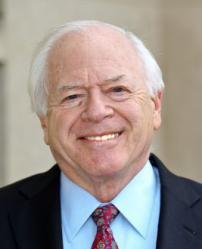
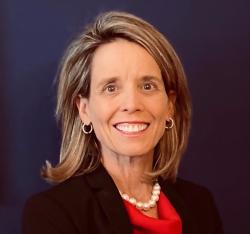
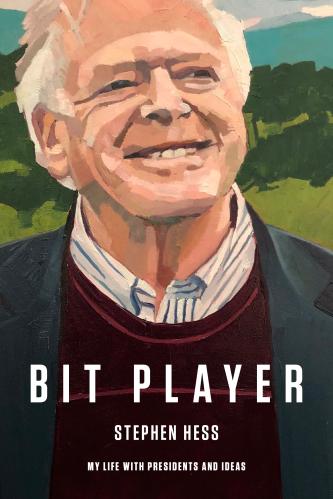
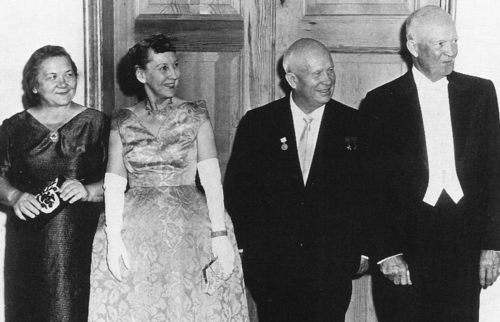
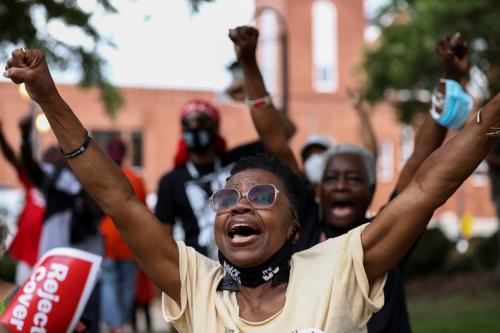
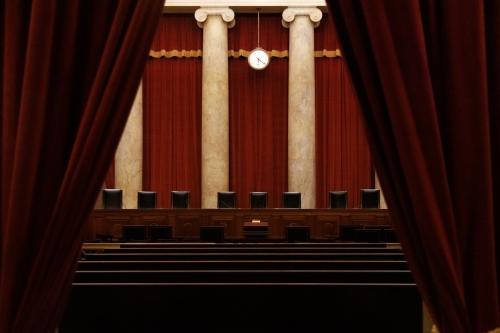
Commentary
PodcastEpisode 2: Writing speeches for President Eisenhower
December 14, 2023